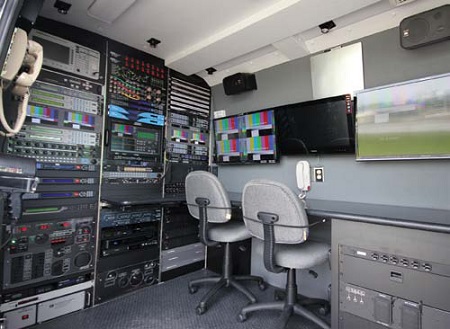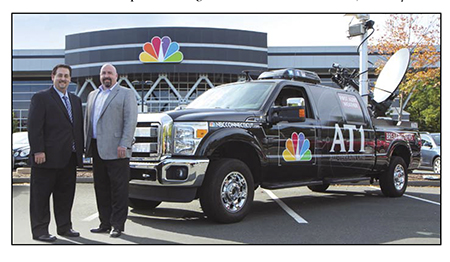Rugged, Reliable and Roadworthy
The interior of a Sprinter DSNG truck recently built by Frontline Communications for New Castle, Colo.-based satellite uplink company Peak Uplink. HAMILTON, N.J.—For the demanding ENG market, the Ford E350 van has been the vehicle of choice for broadcasters. But as Ford will stop manufacturing the E350 by the end of 2014, and GMC will soon curtail production of another popular news platform, the Suburban 2500 SUV, ENG truck vendors say it’s time for broadcasters to start considering suitable alternatives.

In reality, buying an ENG vehicle is not like ordering a new car because the vehicles must be highly customized for this specialized application. Ideally, vehicle chasses should be extremely rugged with GVWRs (gross vehicle weight ratings) of 9,500–9,900 pounds, sufficient to carry all production and transmission gear.
BANNER YEAR
Broadcasters now have many next-generation options that fit the bill, such as the Nissan NV, Ford Transit, Mercedes Benz Sprinter, and GMC Savana 3500, and sales figures show pent-up demand for new ENG vehicles.
Accelerated Media Technology and Frontline Communications— two major ENG vehicle integrators— report that business is up significantly. At AMT in Auburn, Mass., company president Thomas P. Jennings says they customized over 300 vehicles in the past year, a rate he calls “unprecedented.”
“Many stations held off on building new ENG/SNG vehicles for a really long time,” Jennings said. “They thought bonded cellular would be the end-all cure-all but that hasn’t turned out to be entirely true. While bonded cellular is certainly a great tool, people have started to realize its limitations and now they see the need for capable, versatile new vehicles.”
The industry is currently in a “huge replacement cycle, according to Jennings. “Stations that want to be more competitive in news are replacing their older vehicles and expanding their fleets.”
Get the TV Tech Newsletter
The professional video industry's #1 source for news, trends and product and tech information. Sign up below.
Frontline Communications in Clearwater, Fla., just completed a record year, which concluded at the end of September according to the company’s vice president, Jonathan Sherr.
“The Ford E350 has enjoyed an 80 percent market share for newsgathering, so finding a cost-effective, full-featured replacement won’t be easy,” Sherr said. “While we’ve determined that the Mercedes Benz Sprinter and new Ford Transit are well-suited to the rigors of ENG, we believe the Nissan NV cargo van will especially appeal to broadcasters that liked the Ford E350.”
Frontline has already sold 12 NV units, with commitments into 2014 for 30 more units, since they began selling the Nissan NV a few months ago. The Nissan NV has six-foot headroom, allows a low-stowed mast height, has more legroom, and is quieter than a diesel chassis. Frontline offers the NV with a VIP alternator/gel cell-based power system that replaces costly generators and provides up to three hours of reliable ENG operations without the engine running.
According to Jennings, news reporters— especially kids right out of college— prefer to drive vans the size of the E350, and feel that anything larger is too difficult for them to handle safely.

Keith Barbaria, WVIT’s director of technology and engineering, and Jack Kane, station engineer, pose with the station’s new AT1 ENG truck, which is based on a Ford F250 XL Super Duty pickup truck platform. “On fuel economy, the biggest trend is diesel,” he said. “We introduced GMC diesel vans, such as the GMC Savana 3500 at the 2013 NAB, Show and it’s been a runaway success. For a product launch to sell over 100 units in just five months is unheard of and we did that.” While the Savana/diesel van costs more than Ford gas-powered vans, Jennings says its lower operating costs offset that up-front price premium.
“Diesel vans are twice as fuel-efficient as gas motors, require far less maintenance, and low-sulpher diesel is plentiful,” he said. “The GMC Savana 3500 is also very sturdy for all the additional gear you have to put on them and GMC diesel motors are very powerful.”
According to Frontline’s Sherr, the new Ford Transit, essentially Ford’s replacement for the E350, can also be ordered with a diesel engine. While diesel can add as much as $30,000 to the base cost, Sherr agrees that upfront costs are offset by fuel efficiency and double the longevity of gas vehicles.
“But keep in mind that 95 percent of broadcast trucks are gas chasses because acquisition costs are lower, gas is easy to get, and there’s no risk of confusing what type of fuel to put in,” Sherr said. Frontline built more than 50 Diesel Ford E350 ENG vans before Ford discontinued putting the Power Stroke engine in E350s in 2010. For those chasses, an 8 kW diesel generator could be put behind the rear axle.
“The issue with the GM vans with the Isuzu Dura-Max diesel [engines] is that there’s no room for a separate diesel generator behind the rear axle and thus the power source must be an engine-mounted 14 VDC alternator requiring the Isuzu V-8 diesel to be running constantly at rampedup idle to produce power for the electrical system,” said Frontline’s International Sales Manager Bob King. “That’s not so much a mechanical problem as it is a noise problem for many stations.”
Frontline chose the Nissan NV as a more than suitable platform because with its more efficient engine-mounted 28 VDC alternator/power system, the much quieter gasoline engine develops full power at normal idle of 750 rpm.
In terms of four-wheel drive vehicles, like the Subaru Forrester, Sherr says these vehicles represent a very small portion of the business, and appeal to broadcasters in areas with rough terrain or severe weather.
A DREAM SOLUTION
In June 2013, NBC Connecticut/WVIT-TV took delivery of AT1 (All Terrain One), a one-of-a-kind ENG vehicle custom-designed by the station’s director of technology and engineering, Keith Barbaria, and engineer, Jack Kane, to address the unique needs in their market. AT1, which AMT customized for WVIT, is based on a Ford F250 XL Super Duty pickup truck that supports 14,000 pounds.
“After covering severe storms like Hurricane Sandy, Hurricane Irene, and numerous blizzards and snow storms, it became clear to us that we needed safe, reliable, ergonomic ENG/SNG vehicles to get our crews to the scenes of breaking news quickly and be first in our market to air the story,” Barbaria said. “The AT1 and other ENG/SNG vehicles in our fleet are four-wheel drive so they can power through unplowed roads and other inclement conditions.”
Using WVIT’s designs, AMT cut the pickup’s chassis in half and extended it by 18-inches in the middle, creating space for a rack of HD signal transmission and production gear. Operators sit on the back seat to access the equipment including Kaband satellite, microwave, bonded cellular gear, wireless HD camera system, custom-built PC to edit HD video, and a Panasonic AG-HMX100 switcher and multiviewer for multicamera production. A satellite dish and a 32-foot microwave mast with a directional and omni-directional antenna are mounted on the flatbed.
“The AT1 also solves another big challenge in our DMA—driving under Connecticut’s low bridges and overpasses— another tactical advantage that helps meet our goal of being first to broadcast live pictures from news scenes,” Barbaria added.
“In transit, an RF Mogul SDC1 auto-satellite system locates and peaks on the assigned satellite in minutes so photographers and reporters can just hop out and start backhauling video.” Cameras mounted on the dashboard can be switched from exterior views to the reporter in the passenger seat for “Live and Drive” reports, which involves transmitting live while driving.
“WVIT moved up from third to second in the [Hartford/New Haven] market for news [in the A25-54 demo] and with the AT1 we’re confident that we’re continuing forward along a strong, positive trajectory,” said WVIT General Manager Ric Harris.

